Cross-Cultural Management: Eastern vs. Western Managerial Approaches
VerifiedAdded on 2020/03/07
|12
|2626
|39
Essay
AI Summary
This essay provides a comprehensive comparison of Eastern and Western management styles, exploring the impact of cultural dimensions on leadership and business practices. The analysis is structured around Hofstede's five dimensions of national culture: individualism versus collectivism, short-term versus long-term orientation, masculinity versus femininity, and low-risk versus high-risk avoidance. The essay contrasts the emotional responses, decision-making processes, and relationship-building approaches of managers from both cultural backgrounds. It highlights the challenges faced by Western managers operating in Eastern markets, emphasizing the importance of understanding cultural nuances such as collectivism, long-term perspectives, and the preference for harmonious interpersonal relationships. The conclusion summarizes key challenges for Western managers, including adapting to collective decision-making, building long-term relationships, and employing negotiation skills to resolve conflicts, and adapting to a more gradual approach to change. The essay uses examples to illustrate how cultural differences can influence organizational behavior and management effectiveness. The essay references several academic sources to support its arguments.

Running Head: Western Manager Vs. Eastern Manager 1
.0
Different moods and emotions of eastern versus western managers
Student’s Name
Upreta
Professor’s Name
Course Name
.0
Different moods and emotions of eastern versus western managers
Student’s Name
Upreta
Professor’s Name
Course Name
Paraphrase This Document
Need a fresh take? Get an instant paraphrase of this document with our AI Paraphraser
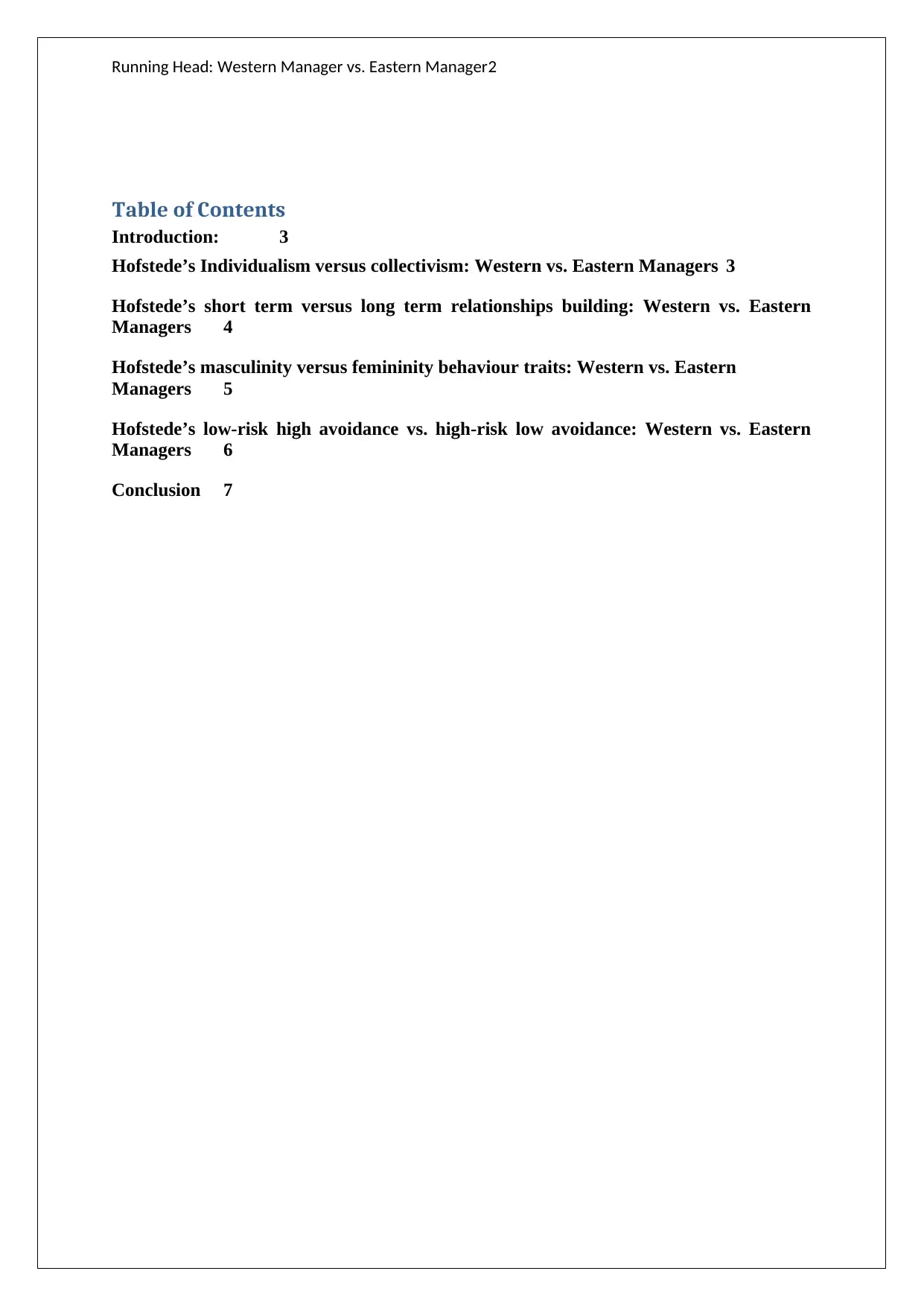
Running Head: Western Manager vs. Eastern Manager2
Table of Contents
Introduction: 3
Hofstede’s Individualism versus collectivism: Western vs. Eastern Managers 3
Hofstede’s short term versus long term relationships building: Western vs. Eastern
Managers 4
Hofstede’s masculinity versus femininity behaviour traits: Western vs. Eastern
Managers 5
Hofstede’s low-risk high avoidance vs. high-risk low avoidance: Western vs. Eastern
Managers 6
Conclusion 7
Table of Contents
Introduction: 3
Hofstede’s Individualism versus collectivism: Western vs. Eastern Managers 3
Hofstede’s short term versus long term relationships building: Western vs. Eastern
Managers 4
Hofstede’s masculinity versus femininity behaviour traits: Western vs. Eastern
Managers 5
Hofstede’s low-risk high avoidance vs. high-risk low avoidance: Western vs. Eastern
Managers 6
Conclusion 7

Running Head: Western Manager vs. Eastern Manager3
Introduction
Cultural differences are becoming an important part of the training and education in the
business organizations today. Businesses, brands, organizations, and markets are crossing
over from national to international but the perceptions about the consumer behaviour and
market demand are bound by the cultural differences affecting the marketing strategies of the
organizations. The cross cultural differences in the consumers and markets are one of the
main reasons behind the failure of many western brands and their products in the eastern
markets.
Firstly, this essay will examine and contrast the emotion and mood of a Western manager
versus an Eastern manager using Hofstede’s five dimensions of national culture of Individual
versus collectivism.
Secondly, this essay will examine and contrast the emotion and mood of a Western manager
versus an Eastern manager using Hofstede’s five dimensions of national culture of short term
versus long term business relationship building.
Thirdly, this essay will examine and contrast the emotion and mood of a Western manager
versus an Eastern manager using Hofstede’s five dimensions of national culture of low-risk
high avoidance vs. high-risk low avoidance.
Fourthly, this essay will examine and contrast the emotion and mood of a Western manager
versus an Eastern manager using Hofstede’s five dimensions of national culture of
masculinity versus femininity behaviour traits.
Fifthly, this essay will examine and contrast the emotion and mood of a Western manager
versus an Eastern manager using Hofstede’s five dimensions of national culture of merit
versus seniority time distance performance of control.
Introduction
Cultural differences are becoming an important part of the training and education in the
business organizations today. Businesses, brands, organizations, and markets are crossing
over from national to international but the perceptions about the consumer behaviour and
market demand are bound by the cultural differences affecting the marketing strategies of the
organizations. The cross cultural differences in the consumers and markets are one of the
main reasons behind the failure of many western brands and their products in the eastern
markets.
Firstly, this essay will examine and contrast the emotion and mood of a Western manager
versus an Eastern manager using Hofstede’s five dimensions of national culture of Individual
versus collectivism.
Secondly, this essay will examine and contrast the emotion and mood of a Western manager
versus an Eastern manager using Hofstede’s five dimensions of national culture of short term
versus long term business relationship building.
Thirdly, this essay will examine and contrast the emotion and mood of a Western manager
versus an Eastern manager using Hofstede’s five dimensions of national culture of low-risk
high avoidance vs. high-risk low avoidance.
Fourthly, this essay will examine and contrast the emotion and mood of a Western manager
versus an Eastern manager using Hofstede’s five dimensions of national culture of
masculinity versus femininity behaviour traits.
Fifthly, this essay will examine and contrast the emotion and mood of a Western manager
versus an Eastern manager using Hofstede’s five dimensions of national culture of merit
versus seniority time distance performance of control.
⊘ This is a preview!⊘
Do you want full access?
Subscribe today to unlock all pages.

Trusted by 1+ million students worldwide
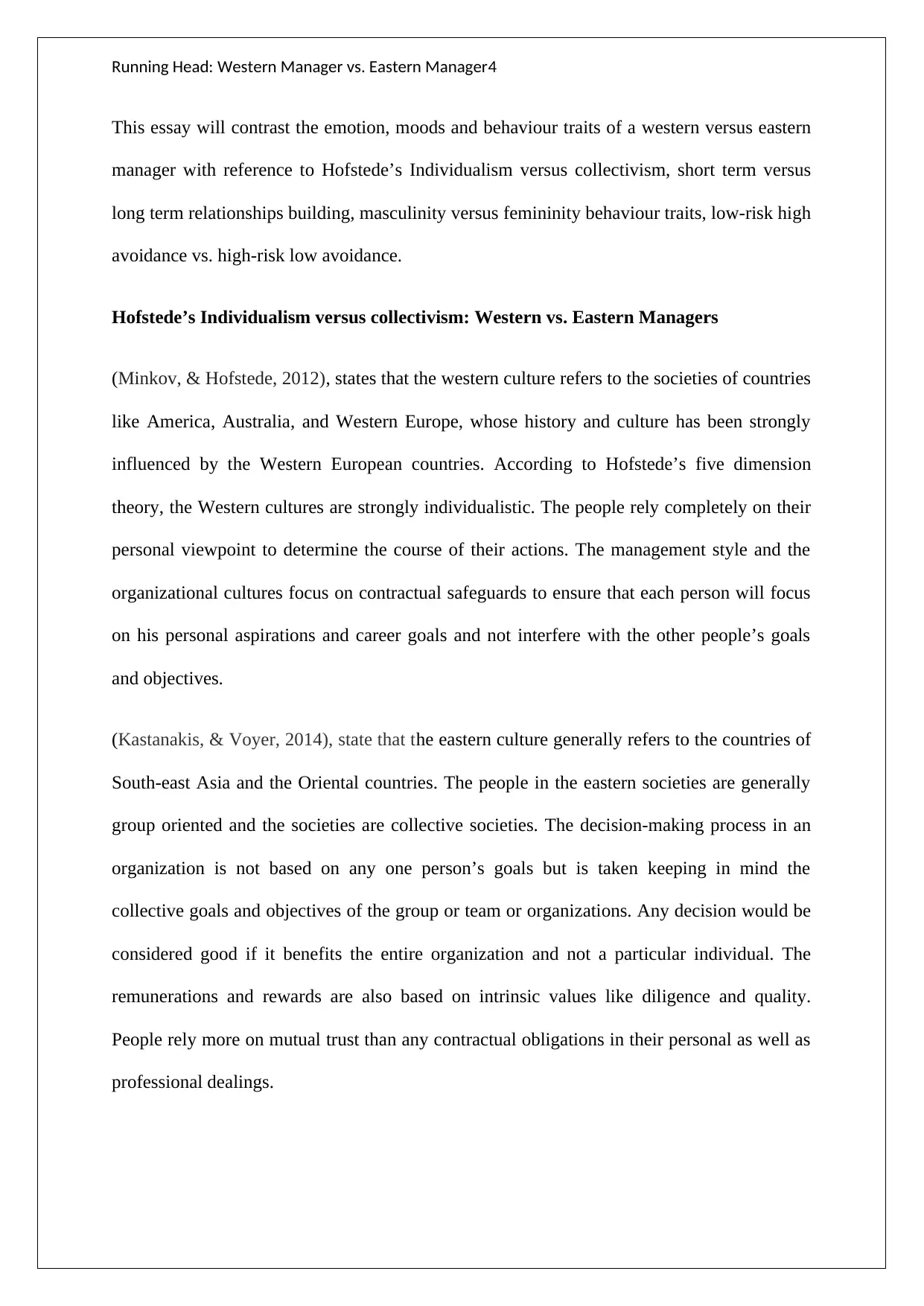
Running Head: Western Manager vs. Eastern Manager4
This essay will contrast the emotion, moods and behaviour traits of a western versus eastern
manager with reference to Hofstede’s Individualism versus collectivism, short term versus
long term relationships building, masculinity versus femininity behaviour traits, low-risk high
avoidance vs. high-risk low avoidance.
Hofstede’s Individualism versus collectivism: Western vs. Eastern Managers
(Minkov, & Hofstede, 2012), states that the western culture refers to the societies of countries
like America, Australia, and Western Europe, whose history and culture has been strongly
influenced by the Western European countries. According to Hofstede’s five dimension
theory, the Western cultures are strongly individualistic. The people rely completely on their
personal viewpoint to determine the course of their actions. The management style and the
organizational cultures focus on contractual safeguards to ensure that each person will focus
on his personal aspirations and career goals and not interfere with the other people’s goals
and objectives.
(Kastanakis, & Voyer, 2014), state that the eastern culture generally refers to the countries of
South-east Asia and the Oriental countries. The people in the eastern societies are generally
group oriented and the societies are collective societies. The decision-making process in an
organization is not based on any one person’s goals but is taken keeping in mind the
collective goals and objectives of the group or team or organizations. Any decision would be
considered good if it benefits the entire organization and not a particular individual. The
remunerations and rewards are also based on intrinsic values like diligence and quality.
People rely more on mutual trust than any contractual obligations in their personal as well as
professional dealings.
This essay will contrast the emotion, moods and behaviour traits of a western versus eastern
manager with reference to Hofstede’s Individualism versus collectivism, short term versus
long term relationships building, masculinity versus femininity behaviour traits, low-risk high
avoidance vs. high-risk low avoidance.
Hofstede’s Individualism versus collectivism: Western vs. Eastern Managers
(Minkov, & Hofstede, 2012), states that the western culture refers to the societies of countries
like America, Australia, and Western Europe, whose history and culture has been strongly
influenced by the Western European countries. According to Hofstede’s five dimension
theory, the Western cultures are strongly individualistic. The people rely completely on their
personal viewpoint to determine the course of their actions. The management style and the
organizational cultures focus on contractual safeguards to ensure that each person will focus
on his personal aspirations and career goals and not interfere with the other people’s goals
and objectives.
(Kastanakis, & Voyer, 2014), state that the eastern culture generally refers to the countries of
South-east Asia and the Oriental countries. The people in the eastern societies are generally
group oriented and the societies are collective societies. The decision-making process in an
organization is not based on any one person’s goals but is taken keeping in mind the
collective goals and objectives of the group or team or organizations. Any decision would be
considered good if it benefits the entire organization and not a particular individual. The
remunerations and rewards are also based on intrinsic values like diligence and quality.
People rely more on mutual trust than any contractual obligations in their personal as well as
professional dealings.
Paraphrase This Document
Need a fresh take? Get an instant paraphrase of this document with our AI Paraphraser
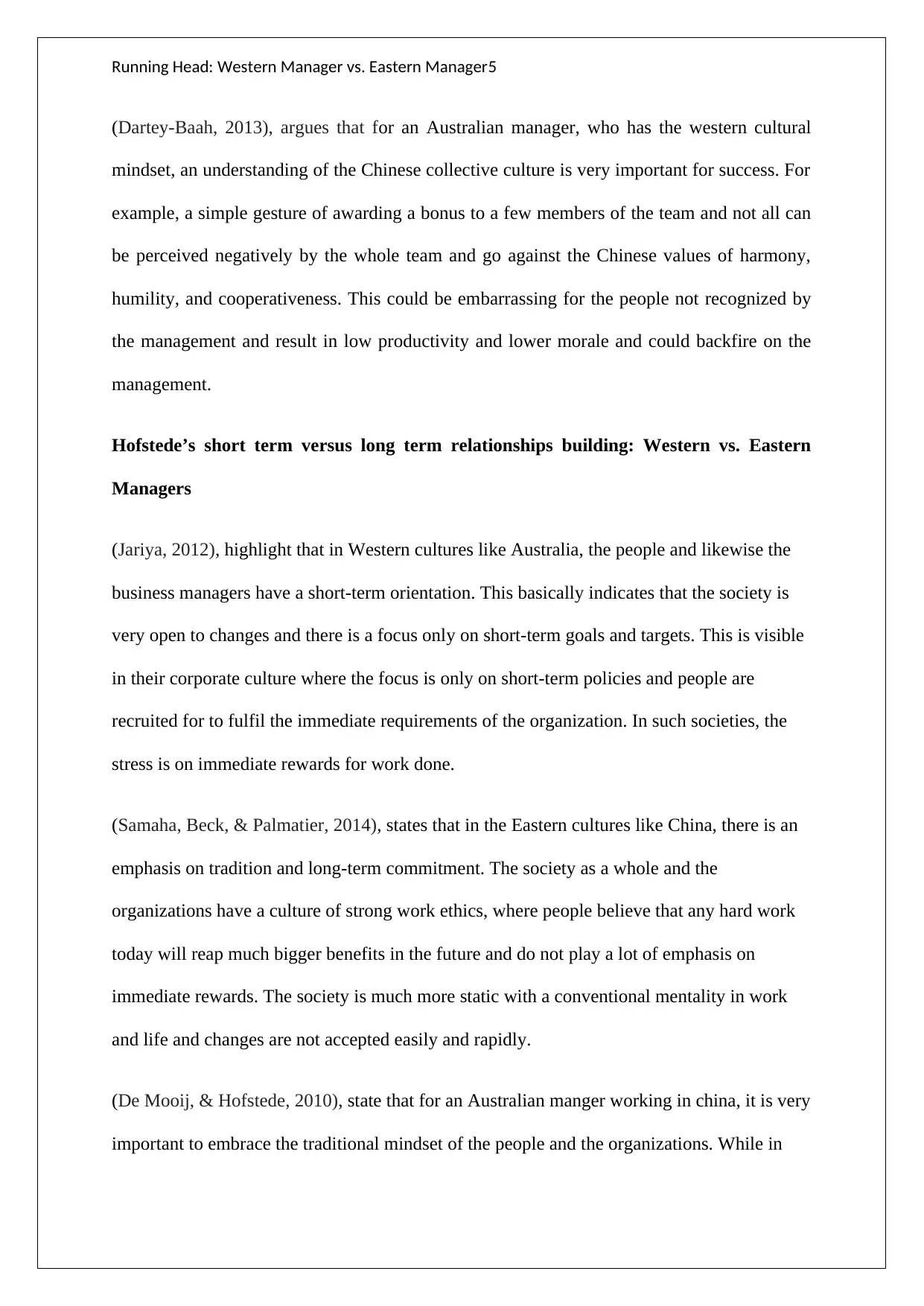
Running Head: Western Manager vs. Eastern Manager5
(Dartey-Baah, 2013), argues that for an Australian manager, who has the western cultural
mindset, an understanding of the Chinese collective culture is very important for success. For
example, a simple gesture of awarding a bonus to a few members of the team and not all can
be perceived negatively by the whole team and go against the Chinese values of harmony,
humility, and cooperativeness. This could be embarrassing for the people not recognized by
the management and result in low productivity and lower morale and could backfire on the
management.
Hofstede’s short term versus long term relationships building: Western vs. Eastern
Managers
(Jariya, 2012), highlight that in Western cultures like Australia, the people and likewise the
business managers have a short-term orientation. This basically indicates that the society is
very open to changes and there is a focus only on short-term goals and targets. This is visible
in their corporate culture where the focus is only on short-term policies and people are
recruited for to fulfil the immediate requirements of the organization. In such societies, the
stress is on immediate rewards for work done.
(Samaha, Beck, & Palmatier, 2014), states that in the Eastern cultures like China, there is an
emphasis on tradition and long-term commitment. The society as a whole and the
organizations have a culture of strong work ethics, where people believe that any hard work
today will reap much bigger benefits in the future and do not play a lot of emphasis on
immediate rewards. The society is much more static with a conventional mentality in work
and life and changes are not accepted easily and rapidly.
(De Mooij, & Hofstede, 2010), state that for an Australian manger working in china, it is very
important to embrace the traditional mindset of the people and the organizations. While in
(Dartey-Baah, 2013), argues that for an Australian manager, who has the western cultural
mindset, an understanding of the Chinese collective culture is very important for success. For
example, a simple gesture of awarding a bonus to a few members of the team and not all can
be perceived negatively by the whole team and go against the Chinese values of harmony,
humility, and cooperativeness. This could be embarrassing for the people not recognized by
the management and result in low productivity and lower morale and could backfire on the
management.
Hofstede’s short term versus long term relationships building: Western vs. Eastern
Managers
(Jariya, 2012), highlight that in Western cultures like Australia, the people and likewise the
business managers have a short-term orientation. This basically indicates that the society is
very open to changes and there is a focus only on short-term goals and targets. This is visible
in their corporate culture where the focus is only on short-term policies and people are
recruited for to fulfil the immediate requirements of the organization. In such societies, the
stress is on immediate rewards for work done.
(Samaha, Beck, & Palmatier, 2014), states that in the Eastern cultures like China, there is an
emphasis on tradition and long-term commitment. The society as a whole and the
organizations have a culture of strong work ethics, where people believe that any hard work
today will reap much bigger benefits in the future and do not play a lot of emphasis on
immediate rewards. The society is much more static with a conventional mentality in work
and life and changes are not accepted easily and rapidly.
(De Mooij, & Hofstede, 2010), state that for an Australian manger working in china, it is very
important to embrace the traditional mindset of the people and the organizations. While in
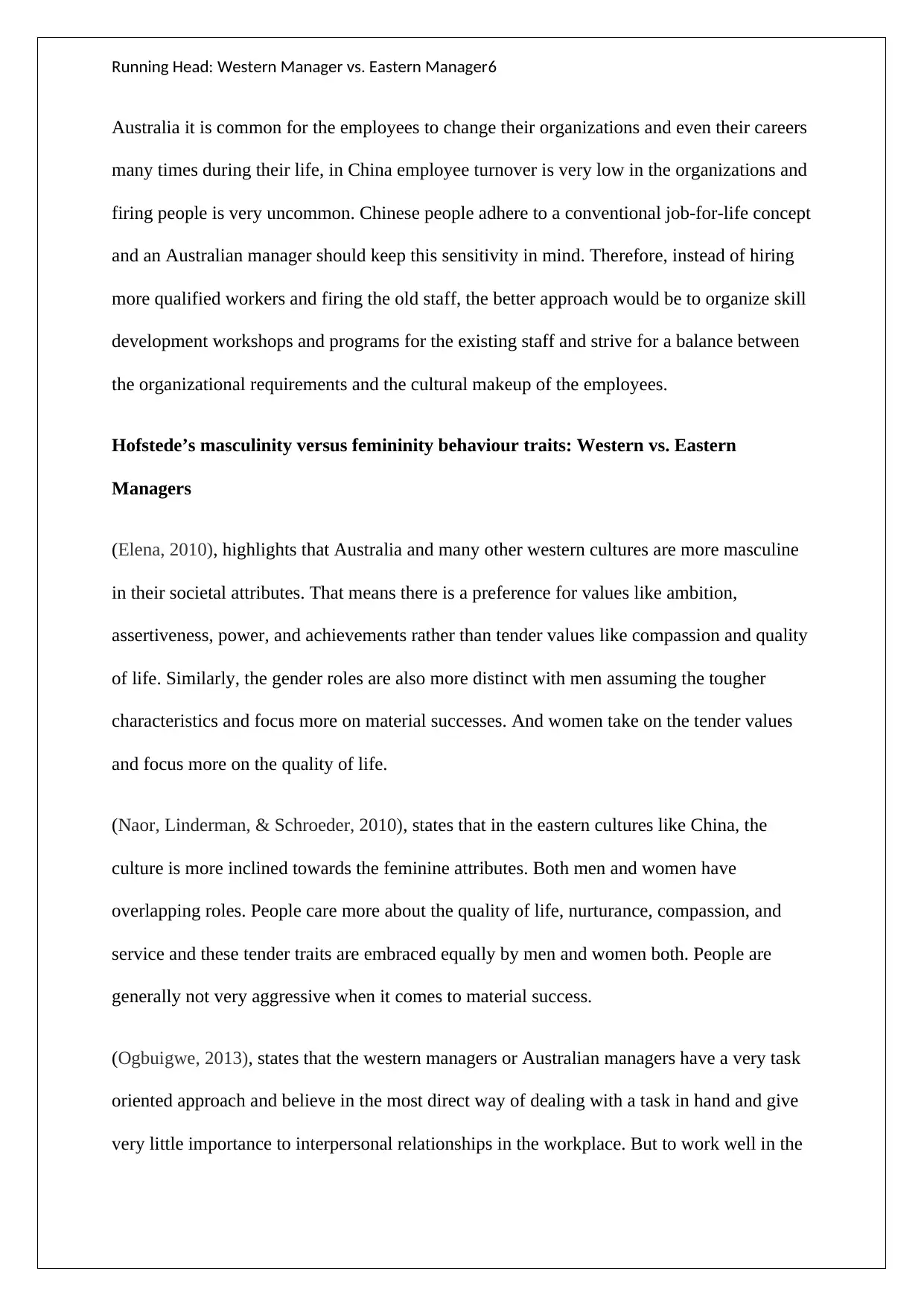
Running Head: Western Manager vs. Eastern Manager6
Australia it is common for the employees to change their organizations and even their careers
many times during their life, in China employee turnover is very low in the organizations and
firing people is very uncommon. Chinese people adhere to a conventional job-for-life concept
and an Australian manager should keep this sensitivity in mind. Therefore, instead of hiring
more qualified workers and firing the old staff, the better approach would be to organize skill
development workshops and programs for the existing staff and strive for a balance between
the organizational requirements and the cultural makeup of the employees.
Hofstede’s masculinity versus femininity behaviour traits: Western vs. Eastern
Managers
(Elena, 2010), highlights that Australia and many other western cultures are more masculine
in their societal attributes. That means there is a preference for values like ambition,
assertiveness, power, and achievements rather than tender values like compassion and quality
of life. Similarly, the gender roles are also more distinct with men assuming the tougher
characteristics and focus more on material successes. And women take on the tender values
and focus more on the quality of life.
(Naor, Linderman, & Schroeder, 2010), states that in the eastern cultures like China, the
culture is more inclined towards the feminine attributes. Both men and women have
overlapping roles. People care more about the quality of life, nurturance, compassion, and
service and these tender traits are embraced equally by men and women both. People are
generally not very aggressive when it comes to material success.
(Ogbuigwe, 2013), states that the western managers or Australian managers have a very task
oriented approach and believe in the most direct way of dealing with a task in hand and give
very little importance to interpersonal relationships in the workplace. But to work well in the
Australia it is common for the employees to change their organizations and even their careers
many times during their life, in China employee turnover is very low in the organizations and
firing people is very uncommon. Chinese people adhere to a conventional job-for-life concept
and an Australian manager should keep this sensitivity in mind. Therefore, instead of hiring
more qualified workers and firing the old staff, the better approach would be to organize skill
development workshops and programs for the existing staff and strive for a balance between
the organizational requirements and the cultural makeup of the employees.
Hofstede’s masculinity versus femininity behaviour traits: Western vs. Eastern
Managers
(Elena, 2010), highlights that Australia and many other western cultures are more masculine
in their societal attributes. That means there is a preference for values like ambition,
assertiveness, power, and achievements rather than tender values like compassion and quality
of life. Similarly, the gender roles are also more distinct with men assuming the tougher
characteristics and focus more on material successes. And women take on the tender values
and focus more on the quality of life.
(Naor, Linderman, & Schroeder, 2010), states that in the eastern cultures like China, the
culture is more inclined towards the feminine attributes. Both men and women have
overlapping roles. People care more about the quality of life, nurturance, compassion, and
service and these tender traits are embraced equally by men and women both. People are
generally not very aggressive when it comes to material success.
(Ogbuigwe, 2013), states that the western managers or Australian managers have a very task
oriented approach and believe in the most direct way of dealing with a task in hand and give
very little importance to interpersonal relationships in the workplace. But to work well in the
⊘ This is a preview!⊘
Do you want full access?
Subscribe today to unlock all pages.

Trusted by 1+ million students worldwide
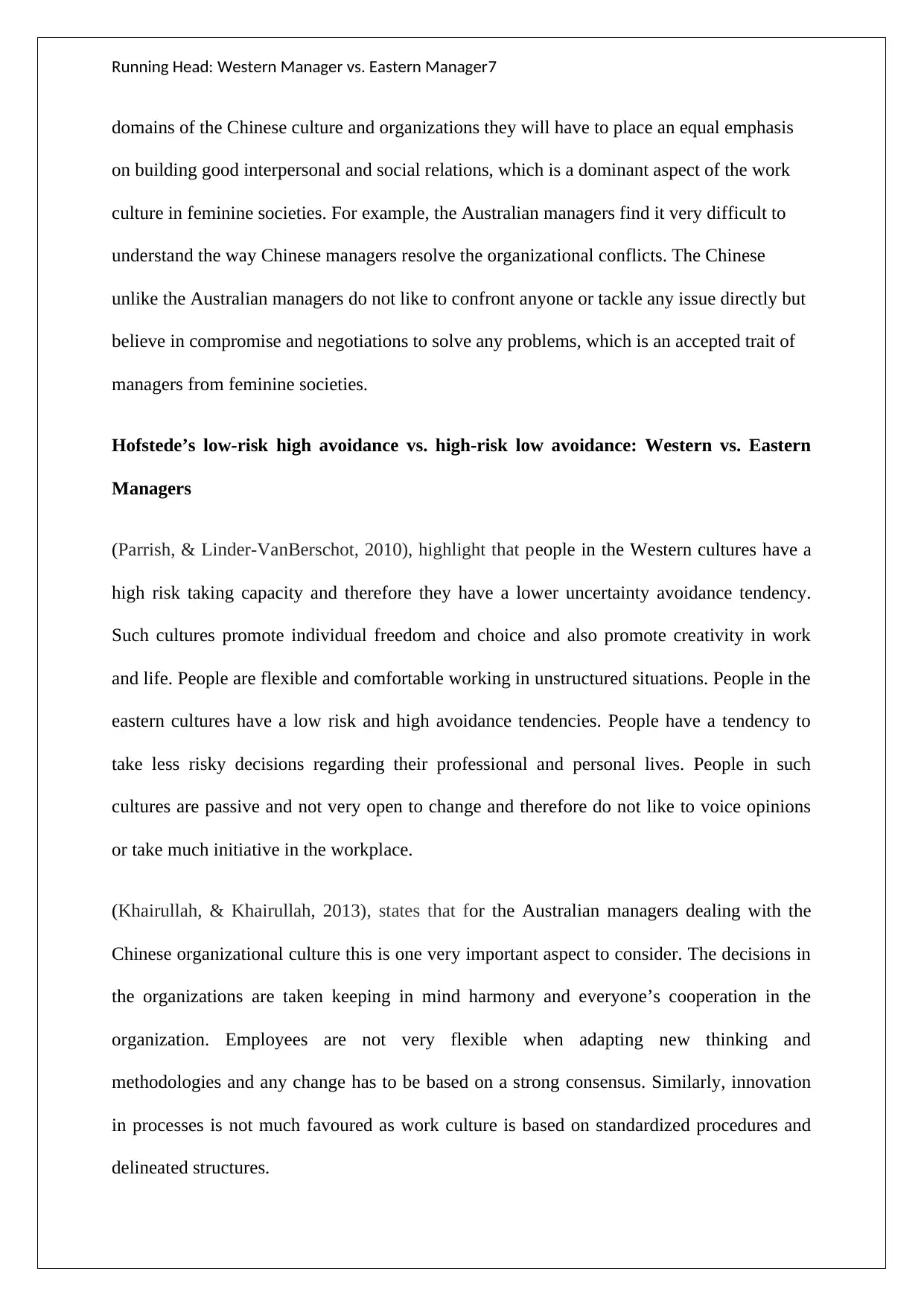
Running Head: Western Manager vs. Eastern Manager7
domains of the Chinese culture and organizations they will have to place an equal emphasis
on building good interpersonal and social relations, which is a dominant aspect of the work
culture in feminine societies. For example, the Australian managers find it very difficult to
understand the way Chinese managers resolve the organizational conflicts. The Chinese
unlike the Australian managers do not like to confront anyone or tackle any issue directly but
believe in compromise and negotiations to solve any problems, which is an accepted trait of
managers from feminine societies.
Hofstede’s low-risk high avoidance vs. high-risk low avoidance: Western vs. Eastern
Managers
(Parrish, & Linder-VanBerschot, 2010), highlight that people in the Western cultures have a
high risk taking capacity and therefore they have a lower uncertainty avoidance tendency.
Such cultures promote individual freedom and choice and also promote creativity in work
and life. People are flexible and comfortable working in unstructured situations. People in the
eastern cultures have a low risk and high avoidance tendencies. People have a tendency to
take less risky decisions regarding their professional and personal lives. People in such
cultures are passive and not very open to change and therefore do not like to voice opinions
or take much initiative in the workplace.
(Khairullah, & Khairullah, 2013), states that for the Australian managers dealing with the
Chinese organizational culture this is one very important aspect to consider. The decisions in
the organizations are taken keeping in mind harmony and everyone’s cooperation in the
organization. Employees are not very flexible when adapting new thinking and
methodologies and any change has to be based on a strong consensus. Similarly, innovation
in processes is not much favoured as work culture is based on standardized procedures and
delineated structures.
domains of the Chinese culture and organizations they will have to place an equal emphasis
on building good interpersonal and social relations, which is a dominant aspect of the work
culture in feminine societies. For example, the Australian managers find it very difficult to
understand the way Chinese managers resolve the organizational conflicts. The Chinese
unlike the Australian managers do not like to confront anyone or tackle any issue directly but
believe in compromise and negotiations to solve any problems, which is an accepted trait of
managers from feminine societies.
Hofstede’s low-risk high avoidance vs. high-risk low avoidance: Western vs. Eastern
Managers
(Parrish, & Linder-VanBerschot, 2010), highlight that people in the Western cultures have a
high risk taking capacity and therefore they have a lower uncertainty avoidance tendency.
Such cultures promote individual freedom and choice and also promote creativity in work
and life. People are flexible and comfortable working in unstructured situations. People in the
eastern cultures have a low risk and high avoidance tendencies. People have a tendency to
take less risky decisions regarding their professional and personal lives. People in such
cultures are passive and not very open to change and therefore do not like to voice opinions
or take much initiative in the workplace.
(Khairullah, & Khairullah, 2013), states that for the Australian managers dealing with the
Chinese organizational culture this is one very important aspect to consider. The decisions in
the organizations are taken keeping in mind harmony and everyone’s cooperation in the
organization. Employees are not very flexible when adapting new thinking and
methodologies and any change has to be based on a strong consensus. Similarly, innovation
in processes is not much favoured as work culture is based on standardized procedures and
delineated structures.
Paraphrase This Document
Need a fresh take? Get an instant paraphrase of this document with our AI Paraphraser
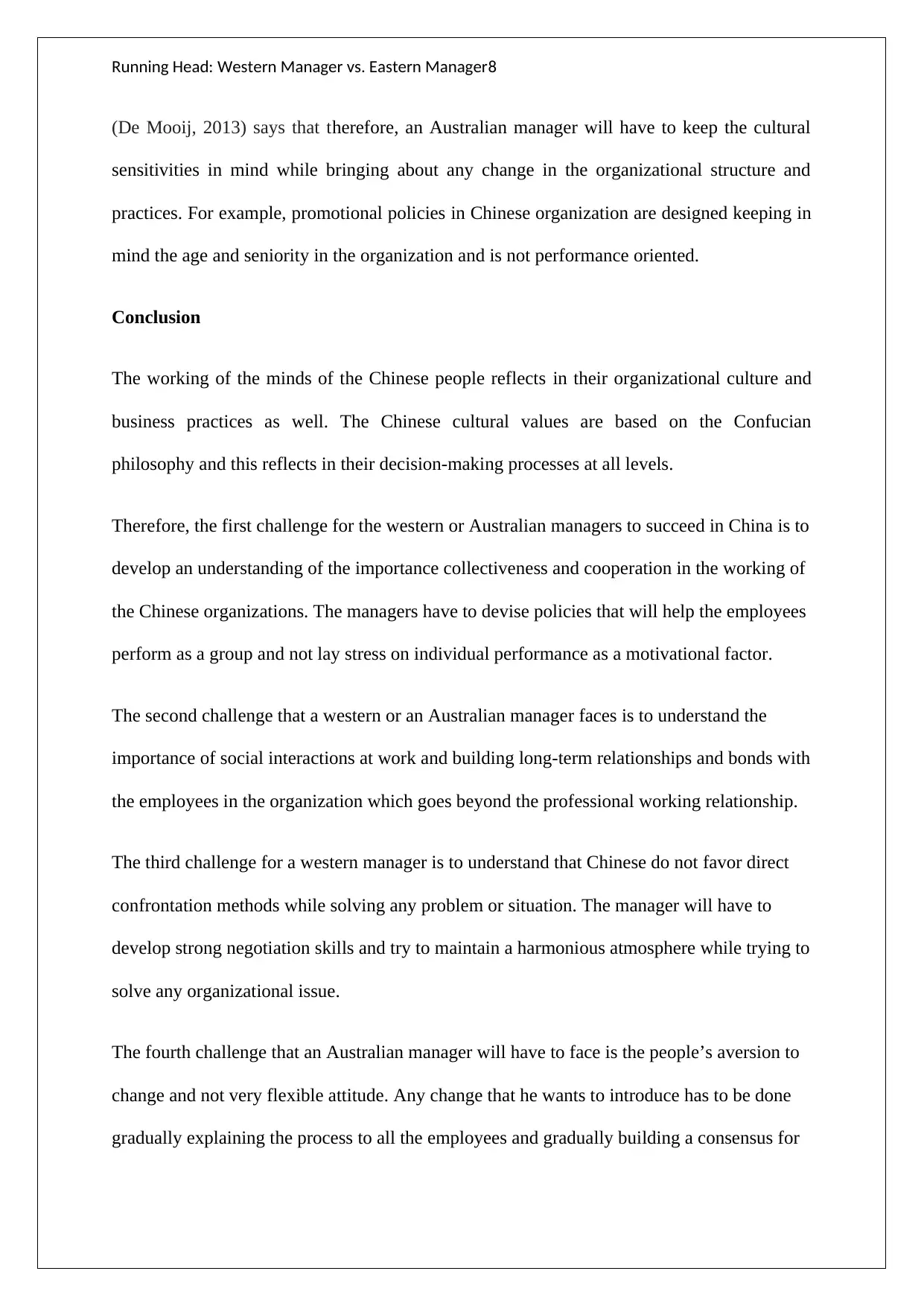
Running Head: Western Manager vs. Eastern Manager8
(De Mooij, 2013) says that therefore, an Australian manager will have to keep the cultural
sensitivities in mind while bringing about any change in the organizational structure and
practices. For example, promotional policies in Chinese organization are designed keeping in
mind the age and seniority in the organization and is not performance oriented.
Conclusion
The working of the minds of the Chinese people reflects in their organizational culture and
business practices as well. The Chinese cultural values are based on the Confucian
philosophy and this reflects in their decision-making processes at all levels.
Therefore, the first challenge for the western or Australian managers to succeed in China is to
develop an understanding of the importance collectiveness and cooperation in the working of
the Chinese organizations. The managers have to devise policies that will help the employees
perform as a group and not lay stress on individual performance as a motivational factor.
The second challenge that a western or an Australian manager faces is to understand the
importance of social interactions at work and building long-term relationships and bonds with
the employees in the organization which goes beyond the professional working relationship.
The third challenge for a western manager is to understand that Chinese do not favor direct
confrontation methods while solving any problem or situation. The manager will have to
develop strong negotiation skills and try to maintain a harmonious atmosphere while trying to
solve any organizational issue.
The fourth challenge that an Australian manager will have to face is the people’s aversion to
change and not very flexible attitude. Any change that he wants to introduce has to be done
gradually explaining the process to all the employees and gradually building a consensus for
(De Mooij, 2013) says that therefore, an Australian manager will have to keep the cultural
sensitivities in mind while bringing about any change in the organizational structure and
practices. For example, promotional policies in Chinese organization are designed keeping in
mind the age and seniority in the organization and is not performance oriented.
Conclusion
The working of the minds of the Chinese people reflects in their organizational culture and
business practices as well. The Chinese cultural values are based on the Confucian
philosophy and this reflects in their decision-making processes at all levels.
Therefore, the first challenge for the western or Australian managers to succeed in China is to
develop an understanding of the importance collectiveness and cooperation in the working of
the Chinese organizations. The managers have to devise policies that will help the employees
perform as a group and not lay stress on individual performance as a motivational factor.
The second challenge that a western or an Australian manager faces is to understand the
importance of social interactions at work and building long-term relationships and bonds with
the employees in the organization which goes beyond the professional working relationship.
The third challenge for a western manager is to understand that Chinese do not favor direct
confrontation methods while solving any problem or situation. The manager will have to
develop strong negotiation skills and try to maintain a harmonious atmosphere while trying to
solve any organizational issue.
The fourth challenge that an Australian manager will have to face is the people’s aversion to
change and not very flexible attitude. Any change that he wants to introduce has to be done
gradually explaining the process to all the employees and gradually building a consensus for
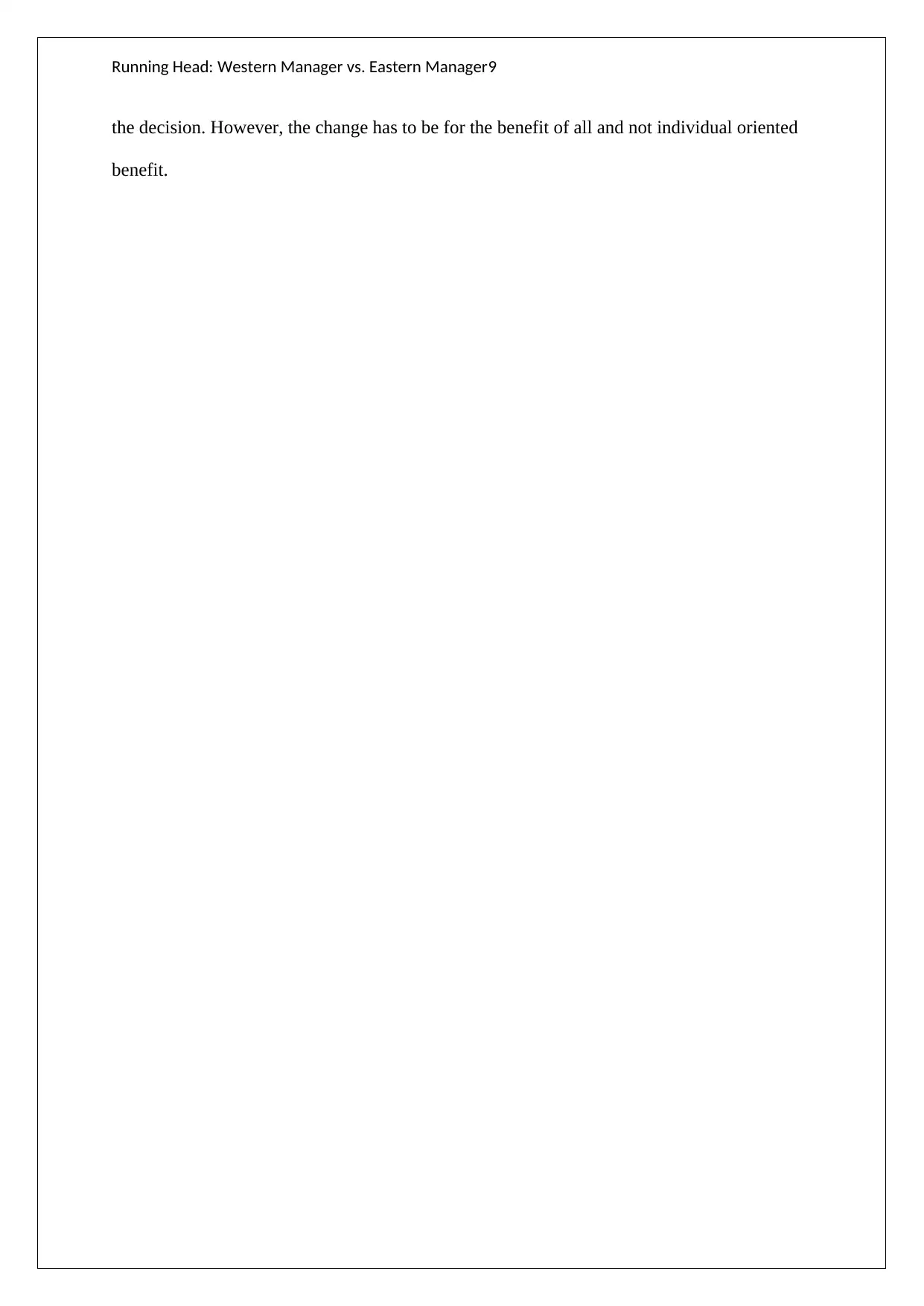
Running Head: Western Manager vs. Eastern Manager9
the decision. However, the change has to be for the benefit of all and not individual oriented
benefit.
the decision. However, the change has to be for the benefit of all and not individual oriented
benefit.
⊘ This is a preview!⊘
Do you want full access?
Subscribe today to unlock all pages.

Trusted by 1+ million students worldwide

Running Head: Western Manager vs. Eastern Manager10
References:
Dartey-Baah, K. (2013). The cultural approach to the management of the international
human resource: An analysis of Hofstede’s cultural dimensions. International Journal of
Business Administration, Volume 4, Issue 2, pp. 39. Retrieved from:
http://www.sciedu.ca/journal/index.php/ijba/article/view/2581
De Mooij, M. (2013). Global marketing and advertising: Understanding cultural
paradoxes. Sage Publications. Retrieved From: https://books.google.co.in/books?
hl=en&lr=&id=YbGNAQAAQBAJ&oi=fnd&pg=PP1&dq=Global+marketing+and+adve
rtising:
+Understanding+cultural+paradoxes.&ots=_CR1mOfffE&sig=R7Tk8bxWh0arnIcMO39
I4qCGTuA#v=onepage&q=Global%20marketing%20and%20advertising%3A
%20Understanding%20cultural%20paradoxes.&f=false
De Mooij, M., & Hofstede, G. (2010). The Hofstede model: Applications to global
branding and advertising strategy and research. International Journal of
Advertising, Volume 29, Issue 1, pp. 85-110. Retrieved from:
http://www.tandfonline.com/doi/abs/10.2501/S026504870920104X
Elena, R. D. (2010). Cultural differences in project management. Annales Universitatis
Apulensis: Series Oeconomica, Volume 12, Issue 2, pp. 657. Retrieved from:
https://search.proquest.com/openview/87b39721b9fa78646948924f666b9615/1?pq-
origsite=gscholar&cbl=276234
Jariya, A. I. (2012). Western cultural values and its implications on management
practices. South East Asian Journal of Contemporary Business, Economics and
Law, Volume 1, pp. 61-70. Retrieved from:
References:
Dartey-Baah, K. (2013). The cultural approach to the management of the international
human resource: An analysis of Hofstede’s cultural dimensions. International Journal of
Business Administration, Volume 4, Issue 2, pp. 39. Retrieved from:
http://www.sciedu.ca/journal/index.php/ijba/article/view/2581
De Mooij, M. (2013). Global marketing and advertising: Understanding cultural
paradoxes. Sage Publications. Retrieved From: https://books.google.co.in/books?
hl=en&lr=&id=YbGNAQAAQBAJ&oi=fnd&pg=PP1&dq=Global+marketing+and+adve
rtising:
+Understanding+cultural+paradoxes.&ots=_CR1mOfffE&sig=R7Tk8bxWh0arnIcMO39
I4qCGTuA#v=onepage&q=Global%20marketing%20and%20advertising%3A
%20Understanding%20cultural%20paradoxes.&f=false
De Mooij, M., & Hofstede, G. (2010). The Hofstede model: Applications to global
branding and advertising strategy and research. International Journal of
Advertising, Volume 29, Issue 1, pp. 85-110. Retrieved from:
http://www.tandfonline.com/doi/abs/10.2501/S026504870920104X
Elena, R. D. (2010). Cultural differences in project management. Annales Universitatis
Apulensis: Series Oeconomica, Volume 12, Issue 2, pp. 657. Retrieved from:
https://search.proquest.com/openview/87b39721b9fa78646948924f666b9615/1?pq-
origsite=gscholar&cbl=276234
Jariya, A. I. (2012). Western cultural values and its implications on management
practices. South East Asian Journal of Contemporary Business, Economics and
Law, Volume 1, pp. 61-70. Retrieved from:
Paraphrase This Document
Need a fresh take? Get an instant paraphrase of this document with our AI Paraphraser
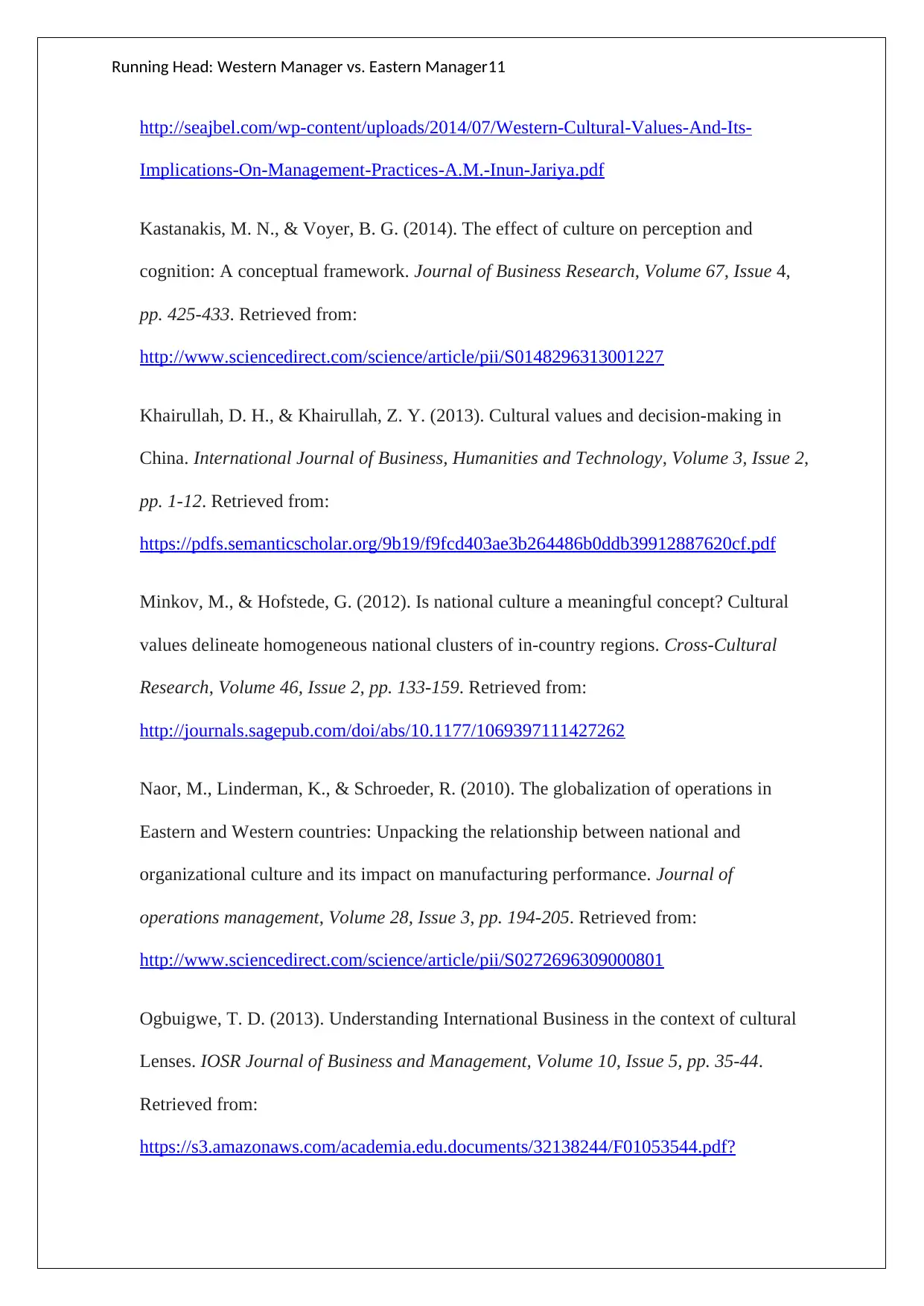
Running Head: Western Manager vs. Eastern Manager11
http://seajbel.com/wp-content/uploads/2014/07/Western-Cultural-Values-And-Its-
Implications-On-Management-Practices-A.M.-Inun-Jariya.pdf
Kastanakis, M. N., & Voyer, B. G. (2014). The effect of culture on perception and
cognition: A conceptual framework. Journal of Business Research, Volume 67, Issue 4,
pp. 425-433. Retrieved from:
http://www.sciencedirect.com/science/article/pii/S0148296313001227
Khairullah, D. H., & Khairullah, Z. Y. (2013). Cultural values and decision-making in
China. International Journal of Business, Humanities and Technology, Volume 3, Issue 2,
pp. 1-12. Retrieved from:
https://pdfs.semanticscholar.org/9b19/f9fcd403ae3b264486b0ddb39912887620cf.pdf
Minkov, M., & Hofstede, G. (2012). Is national culture a meaningful concept? Cultural
values delineate homogeneous national clusters of in-country regions. Cross-Cultural
Research, Volume 46, Issue 2, pp. 133-159. Retrieved from:
http://journals.sagepub.com/doi/abs/10.1177/1069397111427262
Naor, M., Linderman, K., & Schroeder, R. (2010). The globalization of operations in
Eastern and Western countries: Unpacking the relationship between national and
organizational culture and its impact on manufacturing performance. Journal of
operations management, Volume 28, Issue 3, pp. 194-205. Retrieved from:
http://www.sciencedirect.com/science/article/pii/S0272696309000801
Ogbuigwe, T. D. (2013). Understanding International Business in the context of cultural
Lenses. IOSR Journal of Business and Management, Volume 10, Issue 5, pp. 35-44.
Retrieved from:
https://s3.amazonaws.com/academia.edu.documents/32138244/F01053544.pdf?
http://seajbel.com/wp-content/uploads/2014/07/Western-Cultural-Values-And-Its-
Implications-On-Management-Practices-A.M.-Inun-Jariya.pdf
Kastanakis, M. N., & Voyer, B. G. (2014). The effect of culture on perception and
cognition: A conceptual framework. Journal of Business Research, Volume 67, Issue 4,
pp. 425-433. Retrieved from:
http://www.sciencedirect.com/science/article/pii/S0148296313001227
Khairullah, D. H., & Khairullah, Z. Y. (2013). Cultural values and decision-making in
China. International Journal of Business, Humanities and Technology, Volume 3, Issue 2,
pp. 1-12. Retrieved from:
https://pdfs.semanticscholar.org/9b19/f9fcd403ae3b264486b0ddb39912887620cf.pdf
Minkov, M., & Hofstede, G. (2012). Is national culture a meaningful concept? Cultural
values delineate homogeneous national clusters of in-country regions. Cross-Cultural
Research, Volume 46, Issue 2, pp. 133-159. Retrieved from:
http://journals.sagepub.com/doi/abs/10.1177/1069397111427262
Naor, M., Linderman, K., & Schroeder, R. (2010). The globalization of operations in
Eastern and Western countries: Unpacking the relationship between national and
organizational culture and its impact on manufacturing performance. Journal of
operations management, Volume 28, Issue 3, pp. 194-205. Retrieved from:
http://www.sciencedirect.com/science/article/pii/S0272696309000801
Ogbuigwe, T. D. (2013). Understanding International Business in the context of cultural
Lenses. IOSR Journal of Business and Management, Volume 10, Issue 5, pp. 35-44.
Retrieved from:
https://s3.amazonaws.com/academia.edu.documents/32138244/F01053544.pdf?
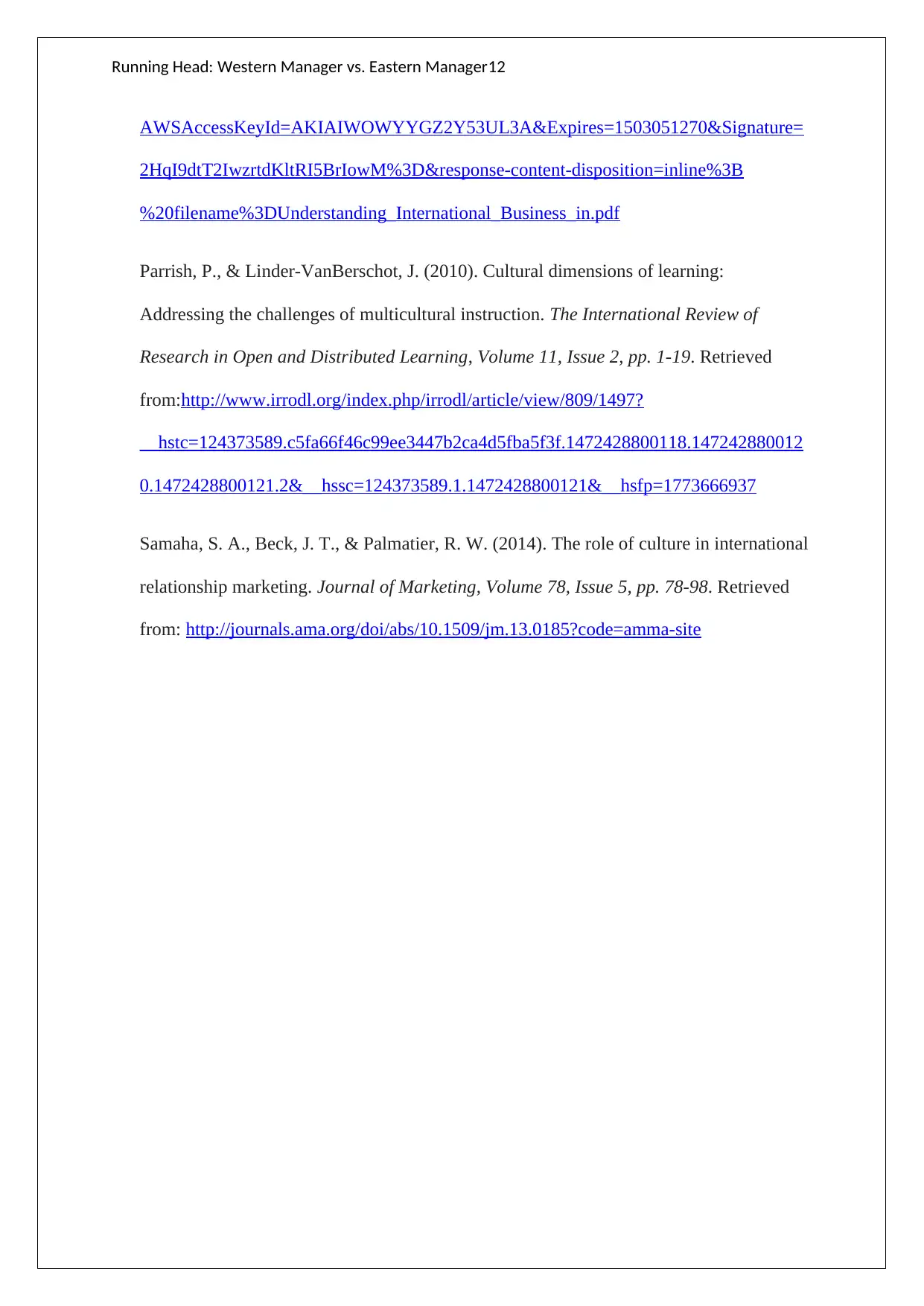
Running Head: Western Manager vs. Eastern Manager12
AWSAccessKeyId=AKIAIWOWYYGZ2Y53UL3A&Expires=1503051270&Signature=
2HqI9dtT2IwzrtdKltRI5BrIowM%3D&response-content-disposition=inline%3B
%20filename%3DUnderstanding_International_Business_in.pdf
Parrish, P., & Linder-VanBerschot, J. (2010). Cultural dimensions of learning:
Addressing the challenges of multicultural instruction. The International Review of
Research in Open and Distributed Learning, Volume 11, Issue 2, pp. 1-19. Retrieved
from:http://www.irrodl.org/index.php/irrodl/article/view/809/1497?
__hstc=124373589.c5fa66f46c99ee3447b2ca4d5fba5f3f.1472428800118.147242880012
0.1472428800121.2&__hssc=124373589.1.1472428800121&__hsfp=1773666937
Samaha, S. A., Beck, J. T., & Palmatier, R. W. (2014). The role of culture in international
relationship marketing. Journal of Marketing, Volume 78, Issue 5, pp. 78-98. Retrieved
from: http://journals.ama.org/doi/abs/10.1509/jm.13.0185?code=amma-site
AWSAccessKeyId=AKIAIWOWYYGZ2Y53UL3A&Expires=1503051270&Signature=
2HqI9dtT2IwzrtdKltRI5BrIowM%3D&response-content-disposition=inline%3B
%20filename%3DUnderstanding_International_Business_in.pdf
Parrish, P., & Linder-VanBerschot, J. (2010). Cultural dimensions of learning:
Addressing the challenges of multicultural instruction. The International Review of
Research in Open and Distributed Learning, Volume 11, Issue 2, pp. 1-19. Retrieved
from:http://www.irrodl.org/index.php/irrodl/article/view/809/1497?
__hstc=124373589.c5fa66f46c99ee3447b2ca4d5fba5f3f.1472428800118.147242880012
0.1472428800121.2&__hssc=124373589.1.1472428800121&__hsfp=1773666937
Samaha, S. A., Beck, J. T., & Palmatier, R. W. (2014). The role of culture in international
relationship marketing. Journal of Marketing, Volume 78, Issue 5, pp. 78-98. Retrieved
from: http://journals.ama.org/doi/abs/10.1509/jm.13.0185?code=amma-site
⊘ This is a preview!⊘
Do you want full access?
Subscribe today to unlock all pages.

Trusted by 1+ million students worldwide
1 out of 12
Related Documents
Your All-in-One AI-Powered Toolkit for Academic Success.
+13062052269
info@desklib.com
Available 24*7 on WhatsApp / Email
![[object Object]](/_next/static/media/star-bottom.7253800d.svg)
Unlock your academic potential
Copyright © 2020–2025 A2Z Services. All Rights Reserved. Developed and managed by ZUCOL.





